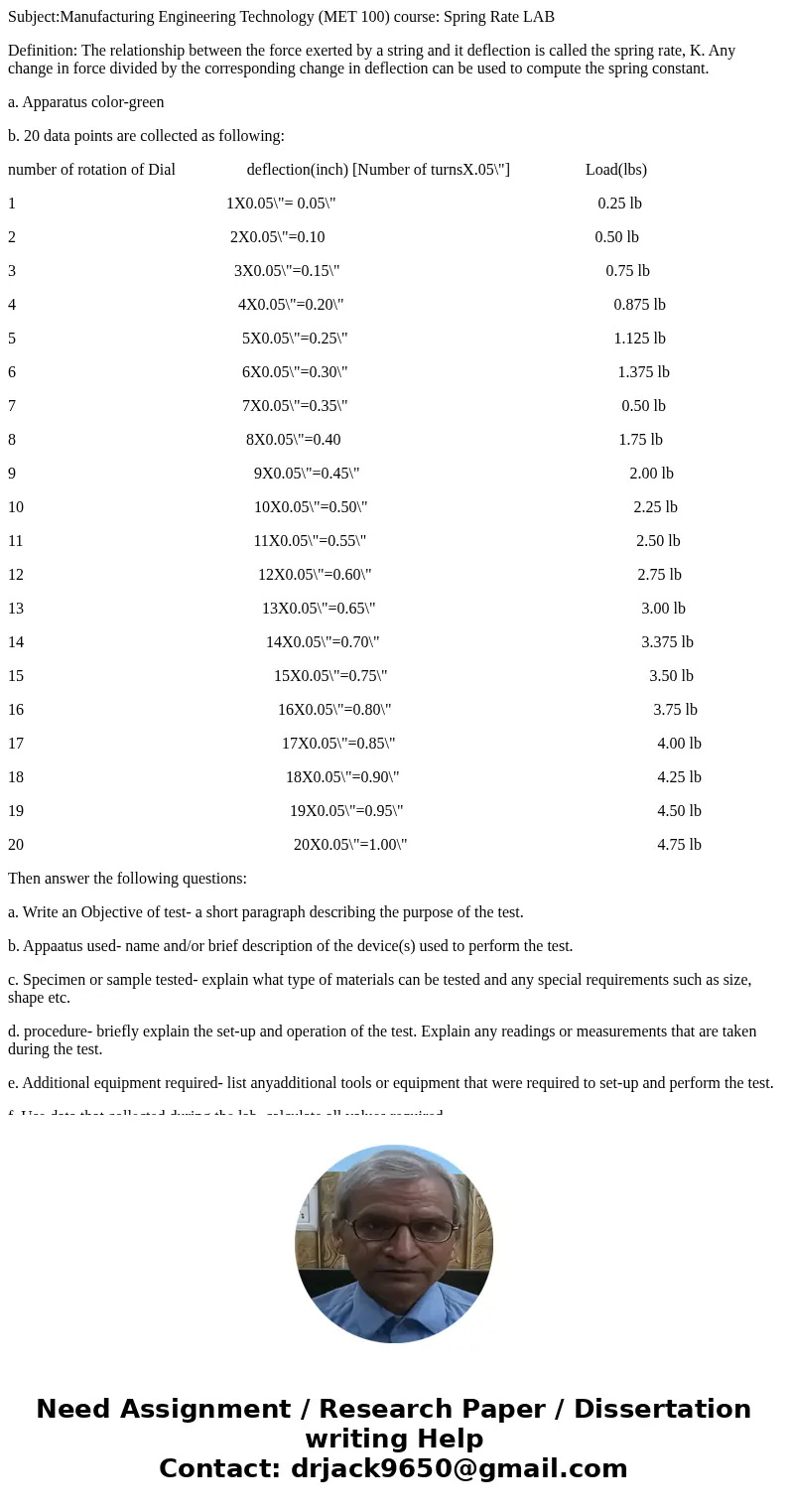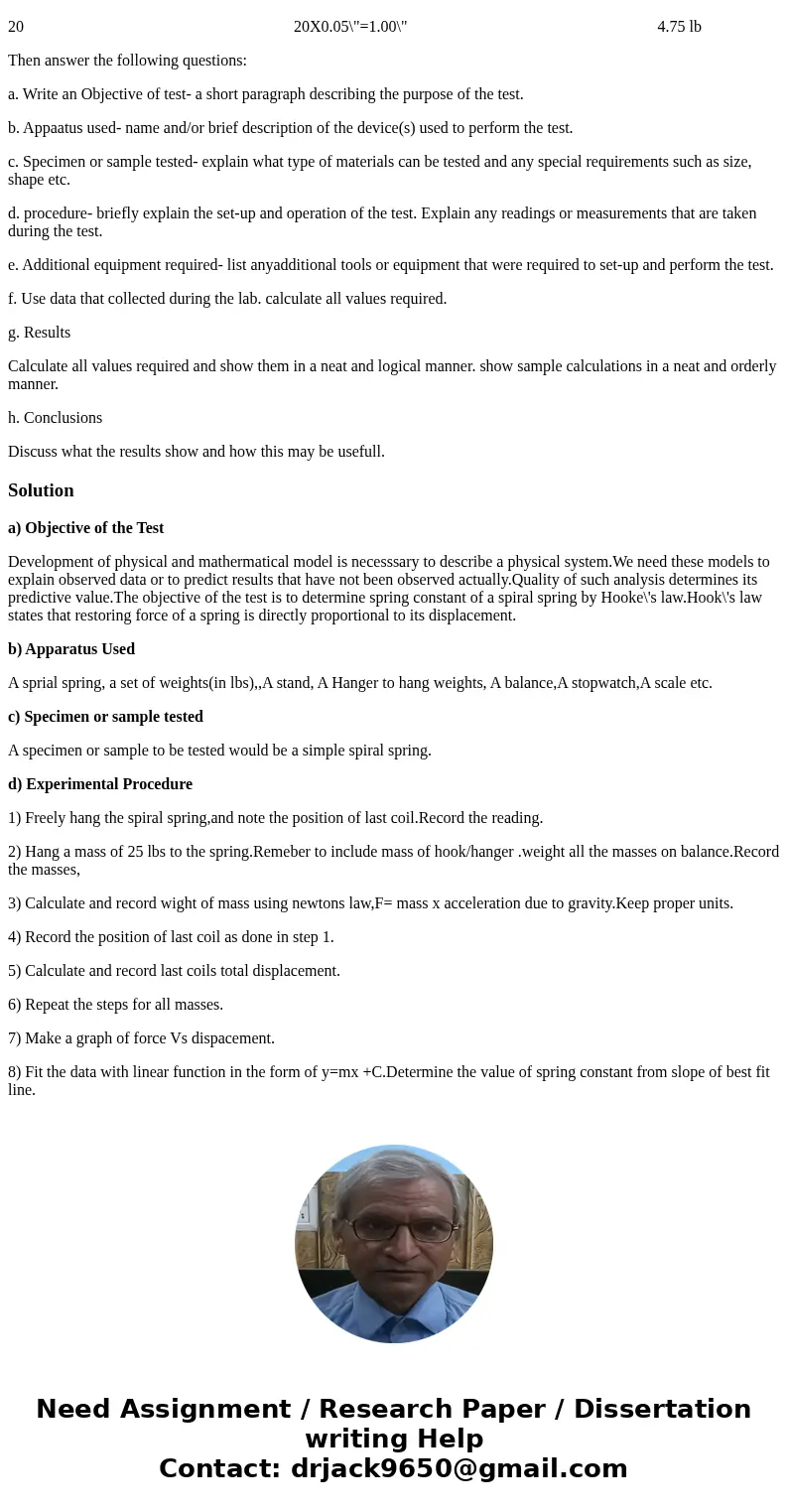SubjectManufacturing Engineering Technology MET 100 course S
Subject:Manufacturing Engineering Technology (MET 100) course: Spring Rate LAB
Definition: The relationship between the force exerted by a string and it deflection is called the spring rate, K. Any change in force divided by the corresponding change in deflection can be used to compute the spring constant.
a. Apparatus color-green
b. 20 data points are collected as following:
number of rotation of Dial deflection(inch) [Number of turnsX.05\"] Load(lbs)
1 1X0.05\"= 0.05\" 0.25 lb
2 2X0.05\"=0.10 0.50 lb
3 3X0.05\"=0.15\" 0.75 lb
4 4X0.05\"=0.20\" 0.875 lb
5 5X0.05\"=0.25\" 1.125 lb
6 6X0.05\"=0.30\" 1.375 lb
7 7X0.05\"=0.35\" 0.50 lb
8 8X0.05\"=0.40 1.75 lb
9 9X0.05\"=0.45\" 2.00 lb
10 10X0.05\"=0.50\" 2.25 lb
11 11X0.05\"=0.55\" 2.50 lb
12 12X0.05\"=0.60\" 2.75 lb
13 13X0.05\"=0.65\" 3.00 lb
14 14X0.05\"=0.70\" 3.375 lb
15 15X0.05\"=0.75\" 3.50 lb
16 16X0.05\"=0.80\" 3.75 lb
17 17X0.05\"=0.85\" 4.00 lb
18 18X0.05\"=0.90\" 4.25 lb
19 19X0.05\"=0.95\" 4.50 lb
20 20X0.05\"=1.00\" 4.75 lb
Then answer the following questions:
a. Write an Objective of test- a short paragraph describing the purpose of the test.
b. Appaatus used- name and/or brief description of the device(s) used to perform the test.
c. Specimen or sample tested- explain what type of materials can be tested and any special requirements such as size, shape etc.
d. procedure- briefly explain the set-up and operation of the test. Explain any readings or measurements that are taken during the test.
e. Additional equipment required- list anyadditional tools or equipment that were required to set-up and perform the test.
f. Use data that collected during the lab. calculate all values required.
g. Results
Calculate all values required and show them in a neat and logical manner. show sample calculations in a neat and orderly manner.
h. Conclusions
Discuss what the results show and how this may be usefull.
Solution
a) Objective of the Test
Development of physical and mathermatical model is necesssary to describe a physical system.We need these models to explain observed data or to predict results that have not been observed actually.Quality of such analysis determines its predictive value.The objective of the test is to determine spring constant of a spiral spring by Hooke\'s law.Hook\'s law states that restoring force of a spring is directly proportional to its displacement.
b) Apparatus Used
A sprial spring, a set of weights(in lbs),,A stand, A Hanger to hang weights, A balance,A stopwatch,A scale etc.
c) Specimen or sample tested
A specimen or sample to be tested would be a simple spiral spring.
d) Experimental Procedure
1) Freely hang the spiral spring,and note the position of last coil.Record the reading.
2) Hang a mass of 25 lbs to the spring.Remeber to include mass of hook/hanger .weight all the masses on balance.Record the masses,
3) Calculate and record wight of mass using newtons law,F= mass x acceleration due to gravity.Keep proper units.
4) Record the position of last coil as done in step 1.
5) Calculate and record last coils total displacement.
6) Repeat the steps for all masses.
7) Make a graph of force Vs dispacement.
8) Fit the data with linear function in the form of y=mx +C.Determine the value of spring constant from slope of best fit line.


 Homework Sourse
Homework Sourse